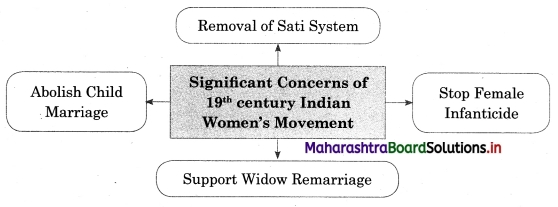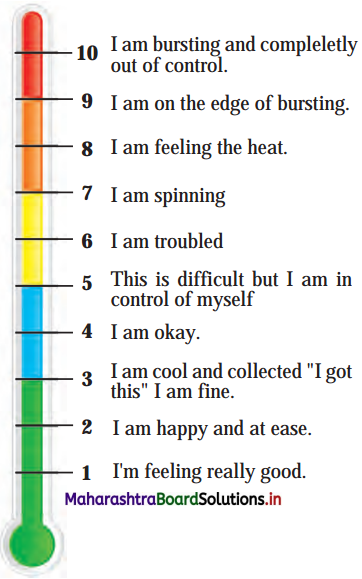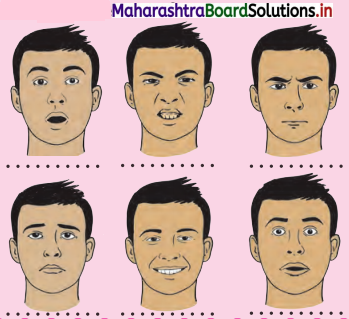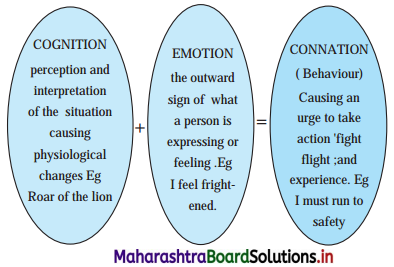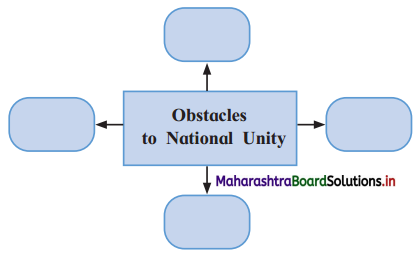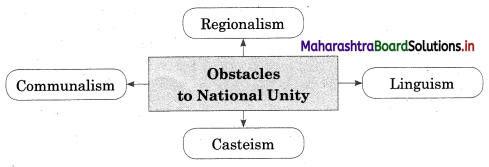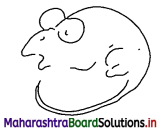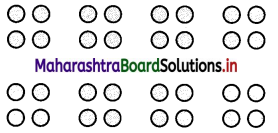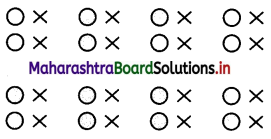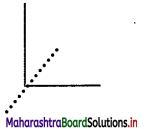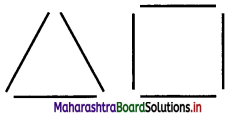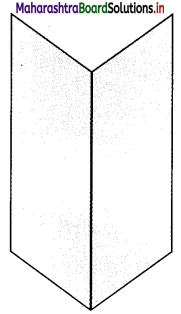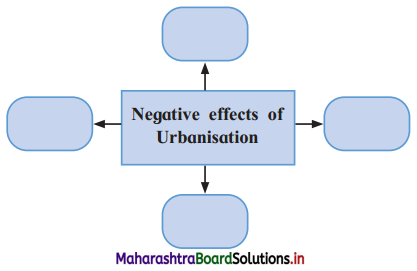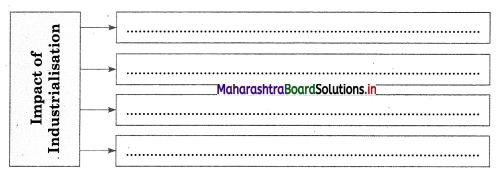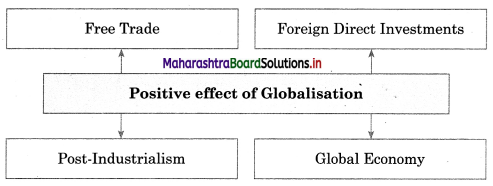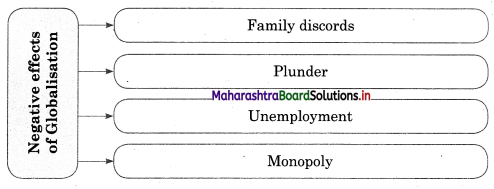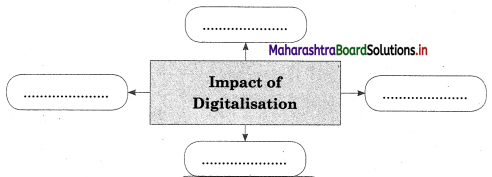Balbharti Maharashtra State Board Class 12 Psychology Solutions Chapter 8 Positive Psychology Textbook Exercise Questions and Answers.
Maharashtra State Board Class 12 Psychology Solutions Chapter 8 Positive Psychology
1. Choose the correct option and complete the following statements.
Question 1.
……………. is the father of positive psychology.
(a) Carver
(b) Masten
(c) Seligman
Answer:
(c) Seligman
Question 2.
Barbara Fredrickson introduced the Broaden and ………………. theory.
(a) Build
(b) Emotion
(c) Learning
Answer:
(a) Build
![]()
Question 3.
The belief that good things will happen is called as ………………..
(a) pessimism
(b) resilience
(c) optimism
Answer:
(c) optimism
Question 4.
The capacity to understand what the other person is experiencing is………………
(a) sympathy
(b) empathy
(c) emotion
Answer:
(b) empathy
2. Answer the following questions in 35 – 40 words each.
Question 1.
Explain the theories of happiness
Answer:
Happiness is a positive emotional state that is subjective to each person, for e.g., people feel happy when they are successful or surprised or loved, etc.
The main theories of happiness are-
- Need/ goal satisfaction theories – Happiness is experienced when some need or goal is satisfied, e.g., Rohit feels happiness when he clears IIT-JEE exams.
- Process/ activity theories – Happiness is experienced when one engages in a particular activity, e.g., Sumit enjoys trekking.
- Genetic/ personality theories – Genetic and personality characteristics are involved in the experience of happiness.
![]()
Question 2.
What is mindfulness?
Answer:
Mindfulness is the basic human ability to be fully aware of where we are and what we are doing. It means that we should not be overly reactive or overwhelmed by what’s going on around us. Mindfulness refers to mental awareness that helps to focus on the ‘Here and Now’. It helps to increase self-regulation, which results in growth and happiness. Mindfulness is maintaining moment by moment awareness of our bodily sensations, environment, thoughts and feelings.
Question 3.
What is resilience?
Answer:
According to the American Psychological Association, resilience is the process of adapting well in the face of adversity, trauma, tragedy, threats or significant sources of stress such as family and relationships, health, work and finances, etc. It is the act of ‘bouncing back’ inspite of barriers or set backs.
Resilience helps the person to recover form setbacks with the least negative consequences. Individuals high on resilience exhibit the following characteristics-
- they regain their confidence after a period of emotional disturbance
- they are able to maintain their psychological well-being.
The types of resilience are physical, psychological, emotional and community resilience.
3. Write short notes on the following in 50 – 60 words each.
Question 1.
Life above zero
Answer:
Traditional psychology focused on life at and below zero. Zero is the line that divides illness form
health. Hence, life below zero indicates a life that is full of problems stress, diseases, etc. Positive psychology emphasizes the study of life above zero.
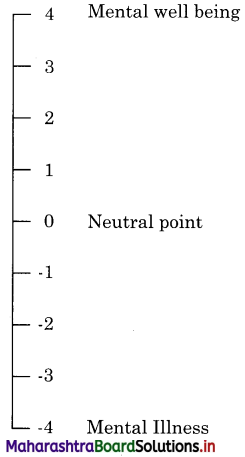
-1 to +1 indicates neutral charactristics while below 0 indicates disorders, dysfunction or illness. Life above zero covers a large area of positive aspects of behaviour such as mindfulness, resilience, happiness, hope, trust and empathy. It acknowledges elements of living that enrich and meaningfully sustain what is referred to as “the good life” in positive psychology.
![]()
Question 2.
Determinants of happiness
Answer:
Happiness is a positive emotional state. Factors like health, prestige, income, success, etc., contribute to only a small portion of our total happiness.
Some factors are predictors of long lasting happiness-
- Strong, intimate social relationships, positive contacts and good support system.
- Optimism leads to less of negative emotions like stress.
- Self-esteem enhances our confidence level and ability to approach challenges in a constructive manner.
- Achieving challenging goals- If the goals are too easy, it leads to boredom and if they are too difficult, it leads to frustration. Moderately challenging goals, increase the chance of success, leading to happiness.
- Perceiving meaning and purpose in life, without which we will experience frustration, boredom, etc.
- Looking at life’s challenges as an opportunity rather than a threat helps to develop our potential.
Question 3.
Characteristics of an optimist
Answer:
Optimism is a mental attitude that includes feelings of hopefulness and a belief that the future will be positive and favourable. It is the belief that negative events are merely setbacks that are temporary and can be overcome.
The characteristics of optimists are:
- they try to choose the best options available
- they tend to be high on self confidence
- they face difficulties positively as they view them as a challenge for a person to become strong
- they are hopeful about the future and do not generalize present failure to future events.
Question 4.
Methods to promote empathy
Answer:
Empathy is the capacity to understand and feel what another person is experiencing from within their frame of reference i.e. capacity to place oneself in another’s position.
According to Simon Baron-Cohen there are three components of empathy viz. cognitive empathy emotional reactivity and social skills. Empathy builds a sense of security and trust. It is closely related to emotional intelligence and is a key to successful relationships.
Empathy can be promoted by using the following methods-
- Increase social interactions – Especially with people who need help in order to understand their perspectives and motives.
- Connecting through similarities – With others, e.g., those having same hobbies/ work/ goals, etc.
- Understanding what you are feeling – Those who are able to accurately judge their own motives, can empathize better.
- Challenge yourself – Tasks that are challenging lead to the person struggling to achieve a goal. This lead to humility which enables empathy.
- Cultivate a sense of curiosity – This leads to open-mindedness and a better understanding of those around us.
- Widen our social circle – Contact with people of different races, cultures, viewpoints helps to increase empathy towards them at a neurological level.
![]()
4. Explain the Following concepts.
Question 1.
Positive Psychology
Answer:
Positive Psychology is a newly emerging branch of psychology. Martin Seligman officially introduced Positive Psychology as a subfield of psychology. It is the science of happiness, human strength and growth. Positive Psychology focuses on building of character strengths like courage, happiness, perseverance, etc., rather than on anxiety, conflict, avoidance, etc. According to Seligman, positive psychology is “the scientific study of positive human functioning and flourishing on multiple levels that include the biological, personal, relational, institutional, cultural and global dimensions of life.”
Question 2.
Half glass full and half glass empty.
Answer:
Optimism is a mental attitude that includes feelings of hopefulness. It is a belief that the future will be positive and favourable and that negative events are merely setbacks that are temporary and can be overcome. Seligman explained about optimism in the book ‘Learned Optimism’. Our perspective determines whether or not we will show optimism.
A glass which has water upto its mid level may be perceived as half full (optimism) or as half empty (pessimism). This is described as ‘Half glass full and half glass empty’.
Question 3.
Empathy
Answer:
Empathy is the capacity to understand and feel what another person is experiencing from within their frame of reference, i.e., capacity to place oneself in another’s position. According to Simon Baron-Cohen, there are three components of empathy viz. cognitive empathy i.e., perspective taking, emotional reactivity (connecting in an intimate bond with another person) and social skills (moved to help the other). Empathy builds a sense of security and trust. It is closely related to emotional intelligence and is a key to successful relationships.
![]()
Question 4.
Mindfulness
Answer:
Mindfulness is the basic human ability to be fully aware of where we are and what we are doing. It means that we should not be overly reactive or overwhelmed by what’s going on around us. Mindfulness refers to mental awareness that helps to focus on the ‘Here and Now’. It helps to increase self-regulation, which results in growth and happiness. Mindfulness is maintaining moment by moment awareness of our bodily sensations, environment, thoughts and feelings.
Question 5.
Social resilience
Answer:
According to the American Psychological Association, resilience is the process of adapting well in the face of adversity, trauma, tragedy, threats or significant sources of stress such as family, health, etc. It is the act of ‘bouncing back’ inspite of barriers or set backs.
Social resilience is also called community resilience. It is the ability of groups of people to respond to and recover from adverse situations such as natural disasters, epidemics, war and socio-economic challenges to their community. This is mainly due to strong connections or bonds that the community members have with each other.
5. Answer the following question in 150 – 200 words each.
Question 1.
What are the essential building blocks of resilience?
Answer:
According to the American Psychological Association, resilience is the process of adapting well in the face of adversity, trauma, tragedy, threats or significant sources of stress such as family, health, etc. It is the act of ‘bouncing back’ inspite of barriers or set backs. Resilience helps the person to recover form setbacks with the least negative consequences. Individuals who are resilience tend to-
- regain their confidence after a period of emotional disturbance
- they are able to maintain their psychological well-being.
![]()
6. The types of resilience are physical, psychological, emotional and community resilience.
According to Ann Masten, building blocks is ‘ordinary magic’, which involves behaviour that can be easily learnt. The 7 C’s of reilience are-
- Competence – Competence is the ability or know-how to handle situations effectively. Competence is acquired through actual experience.
- Confidence – True confidence is a strong belief in one’s own abilities. Confidence is gained by demonstrating competence in real life situations.
- Connection – Family is the central force in an individual’s life. Connections with other people, schools and communities gives the individual a sense of security that allows him/her to be independent and develop creative solutions.
- Character – It refers to a clear sense of right and wrong and a commitment to integrity. An individual with character has a strong sense of self-worth and confidence.
- Contribution – An individual who understands the importance of personal contribution develops a sense of purpose that can motivate him/her, further leading to him/her psychological well-being.
- Coping – A person who learns to cope effectively with stress is better prepared to overcome life’s challenges.
- Control – When an individual realizes that he can control the outcomes of his decisions and actions, he is more likely to know that he has the ability to bounce back.
Question 2.
Recollect the most challenging situation you faced in your life till now and the way you dealt with it. With reference to the 7 C’s of Resilience, which qualities helped you to overcome the challenge? For each of the C’s write the process you adopted to deal with the situation.
Answer:
[Students are expected to answer this question by themselves.]
7. Find out the positive aspects of behaviour from the example given below and answer in one word.
Question 1.
Mahesh studies so attentively that he never gets distracted.
Answer:
Mindfulness
Question 2.
Sujata lost her hands in an accident. Now she has learned to write with her leg.
Answer:
Resilience
![]()
Question 3.
Vasanta’s daughter died by cancer. He has opened a rehabilitation center for cancer patients.
Answer:
Empathy
8. Case Study
Anurag was a software engineer working in one of the leading company’s in the USA for almost 5 years. He was in a stable relationship and he had plans to start a family and to settle there. Unfortunately due to the poor economy in USA he lost his job and had to return back to India. He felt distressed as he realized that he had lost everything he had worked so hard to build. This made him feel like a failure.
- How do you think Anurag can apply the 7 C’s of resilience to overcome the difficult situation he is in?
- As Anurag’s friend how will you empathise with him and help him deal with this challenge?
- Anurag has developed a very pessimistic approach after these setbacks, how will you guide him to stay happy and optimistic?
Answer:
According to the American Psychological Association, resilience is the process of adapting well in the face of adversity, trauma, tragedy, threats or significant sources of stress such as family, health, etc. It is the act of ‘bouncing back’ inspite of barriers or set backs. Resilience helps the person to recover form setbacks. Individuals who are resilient tend to-
(i) regain their confidence after a period of emotional disturbance
(ii) maintain their psychological well-being.
Anurag can apply the 7 C’s of resilience as follows-
1. He has already worked in a reputed firm successfully. Hence he has the Competence and Confidence in his own abilities. Although he is feeling a sense of hopelessness and failure, he must live in the ‘Here and Now’ by taking stock of the situation. Character will provide Anurag self worth and provide a sense of purpose and motivation, i.e., Contribution. When he realizes that he can still succeed in life by applying for a similar job here and accepting the situation, i.e., Control he can use effective Coping mechanisms. Besides, he should not forget social support of family and friends, i.e., Connection.
2. As Anurag’s friend, I can understand and feel what he is going through, from his frame of reference. Since, he is feeling distressed and like a failure due to loss of job, I will empathize with him by being encouraging and supportive. I will try to make him understand that with his own competence and experience, he can easily find a well paying job in India. I will also encourage him to improve his professional skills and seek social support from family and friends.
3. It seems natural for a person who was in a good job, stable relationship and successful position to feel pessimistic and like a failure when all of these no longer exist in his life. I will help Anurag to have a positive approach towards the challenges and difficulties in his life, i.e., view all setbacks i.e. loss of job, being sent back from the USA, etc., as opportunities not as obstacles. This will help him to gain a better perspective.
![]()
Class 12 Psychology Chapter 8 Positive Psychology Intext Questions and Answers
ACTIVITY (Textbook Page. No. 99)
Activity 4
(a) Meera scored poor marks in the examination.
(b) Suresh’s scholarship application got rejected.
(c) Mahesh lost his job.
Imagine yourself in their position and answer the following questions-
(i) How does being in their situation make you feel?
(ii) What do you think about yourself and your future being in their position?
Answer:
(i) You may feel
- Hopeless and so you might think that your future is dark.
- Helpless and so you might think that you cannot do anything to get out of the situation.
- Worthless and so you might think that you are a failure.
(ii) In contrast you may also feel
- Hopeful and think that the current adverse situation can change in the future.
- Challenged and think that you have the ability to overcome the adversity.
- Confident and think that one failure does not define you
Activity 5 (Textbook Page. No. 100)
What would your feeling be in the following situations?
(i) After a long struggle your friend got a job.
(ii) You see a person who just met with an accident and is bleeding profusely.
(iii) Your cousin is awarded a PhD. degree.
Answer:
In all the above examples I would feel empathy i.e., feel what these persons are experiencing.
(i) I will also feel happy and hopeful.
(ii) I will also feel concerned and helpless,
(iii) I will feel elated and proud.
![]()
Activity 8 (Textbook Page. No. 104)
Think of someone you know who has faced a challenging situation in their life and were successfully able to deal with it. This situation may have been emotionally difficult to deal with like death of a loved one, loss of a job, dealing with chronic illness, failure etc. Answer the following questions and discuss the answers in class.
- How did they handle the adverse situation?
- Which obstacles did they have to overcome?
- In your opinion which specific attitudes and skills helped them cope with the situation?
- Do you think they received help and support from others?
Answer:
Sundari, a professor in a reputed college was diagnosed with cancer at age 35 years.
- Initially, she was overcome by feelings of intense fear and hopelessness. However, she decided that she would not give up the fight against cancer.
- She had to overcome obstacles such as intense pain, fear of chemotherapy, pity shown by some ‘well wishers’, financial constraints, etc.
- Specific attitudes that helped her to cope with this trauma were Resilience, fighting spirit interacting with other cancer survivors and good coping skills.
- Yes, she received immense support from family, colleagues, friends and support groups like CPAA and Cancer Aid Foundation.
Activity 9 (Textbook Page. No. 105)
Read about the life of Indian boxer Mary Kom. Discuss in class the struggles she faced and how she overcame them to win multiple medals for the country.
Answer:
Mary Kom was born in Kangathei in the north-east state of Manipur. She grew up in a humble surroundings in an agricultural family. She is the eldest of three siblings. Her father had been a keen wrestler. Since a young age, Mary exhibited an inclination towards sports, like athletics and football. She was inspired by Dingko Singh, (a fellow Manipur who won a gold medal in 1998 Asian games ) to take up boxing. She was unable to pass her matriculation exam but still cleared X Std., from NIOS, Imphal. When she was 15, she left home to study at the Sports Academy in Imphal.
Her first coach K. K. Meitei recalls her as being hard working, dedicated, a quick learner with a strong will power. She has won many accolades such as 6 World Championships, Bronze medal at London Olympics (2012), 1 gold medal each at Asian Games (2014) and at Commonwealth Games (2018). She has been awarded the Padma Shri, Padma Bhushan and Padam Vibushan.
Her life story exhibits how Mary overcome obstacles of poverty, family opposition, gender bias to become the undisputed Queen of Boxing. Even at age 37, she still has the hunger to compete and win medals for India. Mary showed resilience as she has returned to the very demanding sport of boxing, after the birth of each child and has exceeded all expectations.
![]()
Activities 1, 2, 3, and 6
Answer:
[These are personal response questions.]




